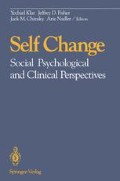Abstract
The measurement of change that at first glance appears relatively simple is, in fact, a complicated endeavor. When discussing these complications Bereiter (1963) noted “…there are not really many instances in the behavioral sciences of promising questions going unresearched because of deficiencies in statistical methodology. Questions dealing with psychological change may well constitute the most important exception (p. 3).” Although the complexity described by Bereiter remains, there have been significant statistical advances since he discussed these issues in 1963. In particular, the introduction of structural equation modeling in psychology (Kenny, 1979) and its application to the measurement of change offers partial solutions to problems that have slowed progress in this area.
Access this chapter
Tax calculation will be finalised at checkout
Purchases are for personal use only
Preview
Unable to display preview. Download preview PDF.
References
Achen, C. H. (1986). The statistical analysis of quasi-experiments. Berkeley, CA: University of California Press.
Bereiter, C. (1963). Some persisting dilemmas in the measurement of change. In C. W. Harris (Ed.), Problems in measuring change (pp. 3–20 ). Madison, WI: University of Wiscons in Press.
Bentler, P. (1985). Theory and implementation of EQS: A structural equations program. Los Angeles, CA: BMDP Statistical Software.
Campbell, D. T. & Fiske, D. W. (1959). Convergent and discriminant validation by the multitrait-multimethod matrix. Psychological Bulletin, 56, 81–105.
Campbell, D. T. & Stanley, J. C. (1963). Experimental and quasi-experimental designs for research on teaching. In N.L. Gage (Ed.), Handbook for research on teaching (pp. 171–246 ). Chicago: Rand McNally.
Cook, T. D. (1985). Postpositivist critical multiplism. In R. L. Shotland & M. M. Mark (Eds.), Social science and social Policy (pp. 21–62 ). Beverly Hills, CA: Sage.
Cronbach, L. E. & Furby, L. (1970). How should we measure“change”–or should we? Psychological Bulletin, 74, 68–80.
Dwyer, J. H. (1984). The excluded variable problem in nonrandomized control group designs. Evaluation Review, 8, 559–572.
Fisher, J. D., Silver, R.C., Chinsky, J., Goff, B., Klar, Y. & Zagieboylo, C. (1989). Psychological effects of participation in a large group awareness training. Journal of Consulting and Clinical Psychology, 57, 747–755.
Gulliksen, H. (1950). Theory of mental tests. New York: Wiley.
Harris, C. W. (1963). Problems in measuring change. Madison, WI: University of Wiscons in Press.
Holtzman, W. H. (1963). Statistical models for the study of change in the single case. In C. W. Harris (Ed.), Problems in measuring change (pp. 199–211 ). Madison, WI: University of Wiscons in Press.
Joreskog, K. G. & Sorbom, D. (1986). Analysis of linear structural relationships by maximum likelihood, instrumental variables, and least squares methods. Mooresville, IN: Scientific Software.
Judd, C. M. & Kenny, D. A. (1981). Estimating the effects of social interventions. New York: Cambridge University Press.
Kenny, D. A. (1975). A quasi-experimental approach to assessing treatment effects in the nonequivalent control group design. Psychological Bulletin, 82, 345–362.
Kenny, D. A. (1979). Correlation and causality. New York: Wiley.
Lord, E M. (1960). Large scale covariance analysis when the control variable is fallible. Journal of the American Statistical Association, 55, 307–321.
Lord, E M. (1967). A paradox in the interpretation of group comparisons. Psychological Bulletin, 68, 304–305.
Lord, F. M. (1963). Elementary models for measuring change. In C. W. Harris (Ed.), Problems in measuring change (pp. 21–38 ). Madison, WI: University of Wiscons in Press.
Lord, F. M. & Novick, M. R. (1968). Statistical theories of mental test scores. Reading, MA: Addison-Wesley.
Magidson, J. (1977). Towards a causal model approach for adjusting for pre-existing differences in the nonequivalent control group situation: A general alternative to ANCOVA. Evaluation Quarterly, 1, 399–420.
Malloy, T. E. & Hennen, E (1991). Longitudinal structural equation models of self-initiated change. Unpublished manuscript, Rhode Island College.
Muthen, B. & Joreskog, K. G. (1983). Selectivity problems in quasi-experimental studies. Evaluation Review, 7, 139–174.
Reichardt, C. S. (1979). The statistical analysis of data from nonequivalent group designs. In T. D. Cook & D. T. Campbell (Eds.), Quasi-experimentation: Design and analysis issues for field settings, (pp. 147–205 ). Boston: Houghton Mifflin.
Rotter, J. B. (1966). Generalized expectancies for internal versus external control of reinforcement. Psychological Monographs, 80, (Whole No. 609).
Thomdike, E. L. (1924). The influence of chance imperfections of measures upon the relation of initial score to gain or loss. Journal of Experimental Psychology, 7, 225–232.
Wallston, K. A. & Wallston, B. S. (1981). Health locus of control scales. In H. Lefcourt (Ed.), Research with the locus of control construct, Vol. 1, Assessment methods. New York: Academic Press.
Webster, H. & Bereiter, C. (1963). The reliability of changes measured by mental test scores. In C. W. Harris (Ed.), Problem in measuring change (pp. 39–59 ). Madison, WI: University of Wiscons in Press.
Editor information
Editors and Affiliations
Rights and permissions
Copyright information
© 1992 Springer-Verlag New York, Inc.
About this chapter
Cite this chapter
Malloy, T.E. (1992). Structural Equation Modeling of Self-initiated Change. In: Klar, Y., Fisher, J.D., Chinsky, J.M., Nadler, A. (eds) Self Change. Springer, New York, NY. https://doi.org/10.1007/978-1-4612-2922-3_13
Download citation
DOI: https://doi.org/10.1007/978-1-4612-2922-3_13
Publisher Name: Springer, New York, NY
Print ISBN: 978-1-4612-7720-0
Online ISBN: 978-1-4612-2922-3
eBook Packages: Springer Book Archive

